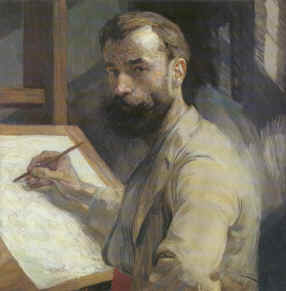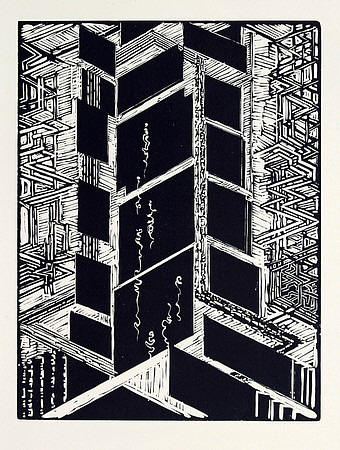František Kupkamalíř a grafik / paitner and graphic artitst
*23. září 1871 v Opočně +24. června 1957 v Puteaux, Francie

František Kupka, autoportrét
Pocházel z Opočna, avšak svoje dětství a mládí (1872-1889) prožil v Dobrušce. Zde se vyučil sedlářskému řemeslu, zde se však také začal prosazovat jeho mimořádný malířský talent. Z iniciativy profesora kreslení Studničky na pokračovací škole v Jaroměři odchází Kupka na malířskou akademii do Prahy k profesoru Sequensovi, později na vídeňskou akademii k profesoru Eisenmergovi.
V roce 1895 přijíždí Kupka do Paříže, kde se záhy uplatnil jako kreslíř a karikaturista. Známé jsou zejména jeho cykly kreseb "Náboženství", "Peníze" a "Mír". Prosadil se i jako ilustrátor (Récluse: Člověk a zem, de Lisle: Erinye, Aristofanes: Lisystrata, Aischylos: Prometheus).
V období let 1905 – 1910 se věnoval portrétní malbě. Od roku 1911 spoluvytvářel moderní abstraktní malbu (orfismus). V roce 1912 vystavuje v Podzimním salónu a o roku později v Salónu neodvislých obrazy "Dvojbarevná fuga", "Sólo hnědé čáry" aj.
Za první světové války se zapojil do činnosti československých legií ve Francii. Po válce se stal profesorem malířských akademií v Praze (pro stipendisty ve Francii) a v Paříži. Natrvalo již zůstává ve Francii.
Svoje umělecké názory shrnul v knize "Tvoření v umění výtvarném" (česky 1923). V letech 1924 a 1936 jsou uspořádány velké výstavy Kupkových děl ve Francii, v roce 1946 v Praze.
Kupkovy prvotiny jsou ve sbírkách Městského muzea v Dobrušce, jeho vrcholná díla v předních světových galeriích. V roce 1994 je instalována nejreprezentativnější výstava Kupkova celoživotního výtvarného díla v Japonsku (Nagoja, Sendai City, Tokio).
Frantisek Kupka was born September 23, 1871, in Opocno in eastern Bohemia. From 1889 to 1892, he studied at the Prague art academy. At this time, he painted historical and patriotic themes. In 1892, Kupka enrolled at the Akademie der Bildenden Künste, Vienna, where he concentrated on symbolic and allegorical subjects. He exhibited at the Kunstverein, Vienna, in 1894. His involvement with theosophy and Eastern philosophy dates from this period. By spring 1896, Kupka had settled in Paris; there he attended the Académie Julian briefly and then studied with Jean-Pierre Laurens at the Ecole des Beaux-Arts.
Kupka worked as an illustrator of books and posters and, during his early years in Paris, became known for his satirical drawings for newspapers and magazines. In 1906, he settled in Puteaux, a suburb of Paris, and that same year exhibited for the first time at the Salon d’Automne. Kupka was deeply impressed by the first Futurist manifesto, published in 1909 in Le Figaro. Kupka’s work became increasingly abstract around 1910–11, reflecting his theories of motion, color, and the relationship between music and painting. In 1911, he attended meetings of the Puteaux group. In 1912, he exhibited at the Salon des Indépendants in the Cubist room, although he did not wish to be identified with any movement.
Creation in the Plastic Arts, a book Kupka completed in 1913, was published in Prague in 1923. In 1921, his first solo show in Paris was held at Galerie Povolozky. In 1931, he was a founding member of Abstraction-Création together with Jean Arp, Albert Gleizes, Jean Hélion, Auguste Herbin, Theo van Doesburg, and Georges Vantongerloo. In 1936, his work was included in the exhibition Cubism and Abstract Art at the Museum of Modern Art, New York, and in an important show with Alphonse Mucha at the Jeu de Paume, Paris. A retrospective of his work took place at the Galerie S.V.U. Mánes in Prague in 1946. The same year, Kupka participated in the Salon des Réalités Nouvelles, Paris, where he continued to exhibit regularly until his death. During the early 1950s, he gained general recognition and had several solo shows in New York. Kupka died in Puteaux on June 24, 1957.

František Kupka
Čtyři příběhy v černé a bílé XXV
dřevoryt / woodcut, 14,5 x 11 cm, 1925, op. 252
25 000 Kč
